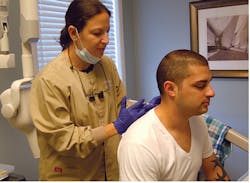Changing patients' lives
Louis Malcmacher, DDS, MAGD
When I lecture to a large group of dentists, I am amazed by how much they enjoy a beautiful before-and-after esthetic case, whether it involves restoring a smile with 20 porcelain veneers or dental implants, or a full-face treatment with Botox and dermal fillers. I always enjoy these cases, as well. They are very satisfying, and you can really change patients' lives by providing the esthetics that give them a younger look and more self-esteem.
But there is another type of patient case that gives me even more satisfaction because it shows how we, as dental health-care professionals, can give patients a better quality of life than ever before.
Let me share with you a great patient story from the American Academy of Facial Esthetics (AAFE) Frontline TMJ/Orofacial Pain Trigger-Point Therapy training course, which occurred during the 2015 American Dental Association (ADA) Annual Meeting in Washington, DC. A wonderful and caring dentist, Meredith Esposito, DMD, brought a patient who had been suffering from TMJ and orofacial pain. The patient, Dan, was a veteran who had served two tours in Iraq.
A thorough medical and dental history was taken, as is important prior to starting any orofacial pain case. Most of Dan's medical and dental history was unremarkable, except for some serious injuries that he sustained in Iraq. Here's the story: He was riding along in a Jeep with his unit when an improvised explosive device (IED) killed his entire unit and injured him. He later recovered from the injuries, but they left him with chronic pain, some of which was severe, in the head and neck. Dan suffered from orofacial pain for approximately a year and sought treatment at the VA. The VA provided some diagnostic tests and treatment, but nothing helped with his severe pain.
Luckily, Dan mentioned this situation to Dr. Esposito, who thought he would be a good-albeit challenging-candidate to bring to the live-patient training AAFE course she was planning to take at the ADA Annual Meeting. Under the direction of AAFE faculty, Dr. Esposito performed a trigger-point muscle examination and identified more than a dozen trigger points that were causing Dan's TMJ and orofacial pain. Using the techniques taught in the course, Dr. Esposito used a combination of ethyl chloride, botulinum toxin (Botox, Allergan, or Xeomin, STATDDS), and trigger-point injections to treat Dan's TMJ and orofacial pain.
To the amazement of Dr. Esposito and many of the other attending dentists, Dan felt some immediate relief. A couple of weeks later, I received an e-mail from Dr. Esposito: "Dan showed up at my office on Friday with candy and flowers! He was in for a cleaning today and was feeling a lot better, muscles less tense. I have another follow-up with him in two weeks, so I will be in touch."
At follow-up appointments, Dr. Esposito used the following treatment plan after further muscle examinations for trigger points: 10 units of botulinum toxin in the frontalis, 20 units in the glabella, 10 units in both the right and left masseter and temporalis muscles, and 10 units in both the right and left splenius capitis and trapezius muscles. Dan also got physical therapy at the VA.
Here is Dr. Esposito's most recent note: "Dan is doing great. He continues physical therapy. Words cannot express how thankful he is. He brought me flowers and candy again! Sorry I couldn't share!"
Dr. Esposito delivers Dan's trigger-point therapy
Thumbs-up and smiles from both Dr. Esposito and Dan
Let's be honest-patients like this have frustrated dentists to the point that most dentists dislike seeing their names on the schedule. But by getting trained, using some time-tested techniques for identifying muscle trigger points, and treating these patients with nonsurgical, minimally invasive procedures and botulinum toxin, every dental professional can deliver this same treatment to patients who suffer from TMJ and orofacial pain. It is time for every dentist to learn how to systematically treat TMJ and orofacial pain patients.
Louis Malcmacher, DDS, MAGD, is a practicing general dentist and an internationally known lecturer and author. Dr. Malcmacher is the president of the American Academy of Facial Esthetics (AAFE) and a consultant for STATDDS. You can contact him at (800) 952-0521 or e-mail [email protected]. You can also visit FacialEsthetics.org to download his resource list, sign up for a free monthly newsletter, or find information about live-patient frontline TMJ/orofacial pain, Botox and dermal fillers training, dental implant training, frontline bruxism therapy and dental sleep medicine, and medical insurance.


